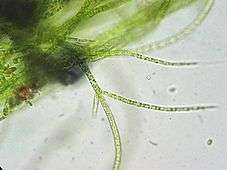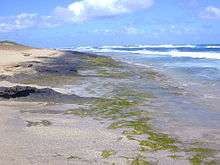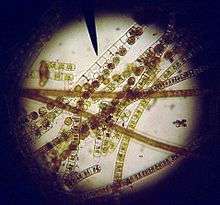Green algae
| Green algae | ||
|---|---|---|
 Stigeoclonium, a chlorophyte green alga genus | ||
| Scientific classification | ||
| ||
| Included groups | ||
| Cladistically included but traditionally excluded groups | ||
The green algae (singular: green alga) are a large, informal grouping of algae consisting of the Chlorophyta and Charophyta/Streptophyta, which are now placed in separate divisions, as well as the more basal Mesostigmatophyceae, Chlorokybophyceae and Spirotaenia.[1][2]
The land plants, or embryophytes, are thought to have emerged from the charophytes.[3] Therefore, cladistically, embryophytes belong to green algae as well. However, because the embryophytes are traditionally classified as neither algae nor green algae, green algae are a paraphyletic group. Since the realization that the embryophytes emerged from within the green algae, some authors are starting to include them.[4][5][6][7][8] The clade that includes both green algae and embryophytes is monophyletic and is referred to as the clade Viridiplantae and as the kingdom Plantae. The green algae include unicellular and colonial flagellates, most with two flagella per cell, as well as various colonial, coccoid and filamentous forms, and macroscopic, multicellular seaweeds. There are about 8,000 species of green algae.[9] Many species live most of their lives as single cells, while other species form coenobia (colonies), long filaments, or highly differentiated macroscopic seaweeds.
A few other organisms rely on green algae to conduct photosynthesis for them. The chloroplasts in euglenids and chlorarachniophytes were acquired from ingested green algae,[3] and in the latter retain a nucleomorph (vestigial nucleus). Green algae are also found symbiotically in the ciliate Paramecium, and in Hydra viridissima and in flatworms. Some species of green algae, particularly of genera Trebouxia of the class Trebouxiophyceae and Trentepohlia (class Ulvophyceae), can be found in symbiotic associations with fungi to form lichens. In general the fungal species that partner in lichens cannot live on their own, while the algal species is often found living in nature without the fungus. Trentepohlia is a filamentous green alga that can live independently on humid soil, rocks or tree bark or form the photosymbiont in lichens of the family Graphidaceae.
Cellular structure
Green algae have chloroplasts that contain chlorophyll a and b, giving them a bright green color, as well as the accessory pigments beta carotene and xanthophylls,[10] in stacked thylakoids.[11] The cell walls of green algae usually contain cellulose, and they store carbohydrate in the form of starch.[12]
All green algae have mitochondria with flat cristae. When present, paired flagella are used to move the cell. They are anchored by a cross-shaped system of microtubules and fibrous strands. Flagella are only present in the motile male gametes of charophytes[13] bryophytes, pteridophytes, cycads and Ginkgo, but are absent from the gametes of Pinophyta and flowering plants.
Members of the class Chlorophyceae undergo closed mitosis in the most common form of cell division among the green algae, which occurs via a phycoplast.[14] By contrast, charophyte green algae and land plants (embryophytes) undergo open mitosis without centrioles. Instead, a 'raft' of microtubules, the phragmoplast, is formed from the mitotic spindle and cell division involves the use of this phragmoplast in the production of a cell plate.[15]
Origins
Photosynthetic eukaryotes originated following a primary endosymbiotic event, where a heterotrophic eukaryotic cell engulfed a photosynthetic cyanobacterium-like prokaryote that became stably integrated and eventually evolved into a membrane-bound organelle: the plastid.[16] This primary endosymbiosis event gave rise to three autotrophic clades with primary plastids: the green plants, the red algae and the glaucophytes.[17]
Evolution and classification

Green algae are often classified with their embryophyte descendants in the green plant clade Viridiplantae (or Chlorobionta). Viridiplantae, together with red algae and glaucophyte algae, form the supergroup Primoplantae, also known as Archaeplastida or Plantae sensu lato. The ancestorial green algae was a unicellular flagellate.[18]
The Viridiplantae diverged into two clades. The Chlorophyta include the early diverging prasinophyte lineages and the core Chlorophyta, which contain the majority of described species of green algae. The Streptophyta include charophytes and land plants. Below is a consensus reconstruction of green algal relationships, mainly based on molecular data. [19][20][21][22][23][24][25][26][27][28][29][30]
| Viridiplantae/ |
| ||||||||||||||||||||||||||||||||||||||||||||||||||||||||||||||||||||||||||||||||||||||||||||||||||||||||||||||||||||||||||||||
| green algae |
The algae of this paraphyletic group "Charophyta" were previously included in Chlorophyta, so green algae and Chlorophyta in this definition were synonyms. As the green algae clades get further resolved, the embryophytes, which are a deep charophyte branch, are included in "algae", "green algae" and "Charophytes", or these terms are replaced by cladistic terminology such as Archaeplastida, Plantae, Viridiplantae or streptophytes, respectively.[31]
Reproduction

Green algae are eukaryotic organisms that follow a reproduction cycle called alternation of generations.
Reproduction varies from fusion of identical cells (isogamy) to fertilization of a large non-motile cell by a smaller motile one (oogamy). However, these traits show some variation, most notably among the basal green algae called prasinophytes.
Haploid algal cells (containing only one copy of their DNA) can fuse with other haploid cells to form diploid zygotes. When filamentous algae do this, they form bridges between cells, and leave empty cell walls behind that can be easily distinguished under the light microscope. This process is called conjugation and occurs for example in Spirogyra.
The species of Ulva are reproductively isomorphic, the diploid vegetative phase is the site of meiosis and releases haploid zoospores, which germinate and grow producing a haploid phase alternating with the vegetative phase.[32]
Sex pheromone
Sex pheromone production is likely a common feature of green algae, although only studied in detail in a few model organisms. Volvox is a genus of chlorophytes. Different species form spherical colonies of up to 50,000 cells. One well-studied species, Volvox carteri (2,000 – 6,000 cells) occupies temporary pools of water that tend to dry out in the heat of late summer. As their environment dries out, asexual V. carteri quickly die. However, they are able to escape death by switching, shortly before drying is complete, to the sexual phase of their life cycle that leads to production of dormant desiccation-resistant zygotes. Sexual development is initiated by a glycoprotein pheromone (Hallmann et al., 1998). This pheromone is one of the most potent known biological effector molecules. It can trigger sexual development at concentrations as low as 10−16M.[33] Kirk and Kirk[34] showed that sex-inducing pheromone production can be triggered experimentally in somatic cells by heat shock. Thus heat shock may be a condition that ordinarily triggers sex-inducing pheromone in nature.[33]
The Closterium peracerosum-strigosum-littorale (C. psl) complex is a unicellular, isogamous charophycean alga group that is the closest unicellular relative to land plants. Heterothallic strains of different mating type can conjugate to form zygospores. Sex pheromones termed protoplast-release inducing proteins (glycopolypeptides) produced by mating-type (-) and mating-type (+) cells facilitate this process.[35]
Physiology
The green algae, including the characean algae, have served as model experimental organisms to understand the mechanisms of the ionic and water permeability of membranes, osmoregulation, turgor regulation, salt tolerance, cytoplasmic streaming, and the generation of action potentials.[36]
References
- ↑ Sánchez-Baracaldo P, Raven JA, Pisani D, Knoll AH (September 2017). "Early photosynthetic eukaryotes inhabited low-salinity habitats". Proceedings of the National Academy of Sciences of the United States of America. 114 (37): E7737–E7745. doi:10.1073/pnas.1620089114. PMID 28808007.
- ↑ Gitzendanner MA, Soltis PS, Wong GK, Ruhfel BR, Soltis DE (March 2018). "Plastid phylogenomic analysis of green plants: A billion years of evolutionary history". American Journal of Botany. 105 (3): 291–301. doi:10.1002/ajb2.1048. PMID 29603143.
- 1 2 Palmer JD, Soltis DE, Chase MW (October 2004). "The plant tree of life: an overview and some points of view". American Journal of Botany. 91 (10): 1437–45. doi:10.3732/ajb.91.10.1437. PMID 21652302.
- ↑ Delwiche CF, Timme RE (June 2011). "Plants". Current Biology. 21 (11): R417–22. doi:10.1016/j.cub.2011.04.021. PMID 21640897.
- ↑ "Charophycean Green Algae Home Page". www.life.umd.edu. Retrieved 2018-02-24.
- ↑ Ruhfel BR, Gitzendanner MA, Soltis PS, Soltis DE, Burleigh JG (February 2014). "From algae to angiosperms-inferring the phylogeny of green plants (Viridiplantae) from 360 plastid genomes". BMC Evolutionary Biology. 14: 23. doi:10.1186/1471-2148-14-23. PMC 3933183. PMID 24533922.
- ↑ Delwiche CF, Cooper ED (October 2015). "The Evolutionary Origin of a Terrestrial Flora". Current Biology. 25 (19): R899–910. doi:10.1016/j.cub.2015.08.029. PMID 26439353.
- ↑ Parfrey LW, Lahr DJ, Knoll AH, Katz LA (August 2011). "Estimating the timing of early eukaryotic diversification with multigene molecular clocks". Proceedings of the National Academy of Sciences of the United States of America. 108 (33): 13624–9. doi:10.1073/pnas.1110633108. PMC 3158185. PMID 21810989.
- ↑ Guiry MD (October 2012). "How many species of algae are there?". Journal of Phycology. 48 (5): 1057–63. doi:10.1111/j.1529-8817.2012.01222.x. PMID 27011267.
- ↑ Burrows 1991. Seaweeds of the British Isles. Volume 2 Natural History Museum, London. ISBN 0-565-00981-8
- ↑ van den Hoek C, Mann DG, Jahns HM (1995). Algae An introduction to phycology. Cambridge: Cambridge University Press. ISBN 978-0-521-30419-1.
- ↑ Judd WS, Campbell CS, Kellogg EA, Stevens PF, Donoghue MJ (2002). Plant systematics, a phylogenetic approach. Sunderland Mass.: Sinauer Associates Inc. p. 156. ISBN 978-0-87893-403-4.
- ↑ Roberts DW (February 1992). "The use of proton nuclear magnetic resonance spectrometry (1H NMR) for monitoring the reaction of epoxides with butylamine and predictive capabilities of the relative alkylation index (RAI) for skin sensitization by epoxides". Toxicology and Applied Pharmacology. 112 (2): 331–2. doi:10.1104/pp.116.1.9. PMC 1539170.
- ↑ Pickett-Heaps J (1976). "Cell division in eucaryotic algae". BioScience. 26 (7): 445–450. doi:10.2307/1297481. JSTOR 1297481.
- ↑ P.H. Raven, R.F. Evert, S.E. Eichhorn (2005): Biology of Plants, 7th Edition, W.H. Freeman and Company Publishers, New York, ISBN 0-7167-1007-2
- ↑ Keeling PJ (March 2010). "The endosymbiotic origin, diversification and fate of plastids". Philosophical Transactions of the Royal Society of London. Series B, Biological Sciences. 365 (1541): 729–48. doi:10.1098/rstb.2009.0103. PMC 2817223. PMID 20124341.
- ↑ De Clerck O, Bogaert KA, Leliaert F (2012). "Diversity and Evolution of Algae". Advances in Botanical Research. Advances in Botanical Research. 64: 55–86. doi:10.1016/B978-0-12-391499-6.00002-5. ISBN 9780123914996. ISSN 0065-2296.
- ↑ Leliaert F (2013-05-29). "Phylogeny and molecular evolution of the green algae". Retrieved 2017-09-09.
- ↑ Lewis LA, McCourt RM (October 2004). "Green algae and the origin of land plants". American Journal of Botany. 91 (10): 1535–56. doi:10.3732/ajb.91.10.1535. PMID 21652308.
- ↑ Leliaert F, Smith DR, Moreau H, Herron MD, Verbruggen H, Delwiche CF, De Clerck O (2012). "Phylogeny and Molecular Evolution of the Green Algae" (PDF). Critical Reviews in Plant Sciences. 31: 1–46. doi:10.1080/07352689.2011.615705.
- ↑ Marin B (September 2012). "Nested in the Chlorellales or independent class? Phylogeny and classification of the Pedinophyceae (Viridiplantae) revealed by molecular phylogenetic analyses of complete nuclear and plastid-encoded rRNA operons". Protist. 163 (5): 778–805. doi:10.1016/j.protis.2011.11.004. PMID 22192529.
- ↑ Laurin-Lemay S, Brinkmann H, Philippe H (August 2012). "Origin of land plants revisited in the light of sequence contamination and missing data". Current Biology. 22 (15): R593–4. doi:10.1016/j.cub.2012.06.013. PMID 22877776.
- ↑ Ruhfel BR, Gitzendanner MA, Soltis PS, Soltis DE, Burleigh JG (February 2014). "From algae to angiosperms-inferring the phylogeny of green plants (Viridiplantae) from 360 plastid genomes". BMC Evolutionary Biology. 14: 23. doi:10.1186/1471-2148-14-23. PMC 3933183. PMID 24533922.
- ↑ Leliaert F, Tronholm A, Lemieux C, Turmel M, DePriest MS, Bhattacharya D, Karol KG, Fredericq S, Zechman FW, Lopez-Bautista JM (May 2016). "Chloroplast phylogenomic analyses reveal the deepest-branching lineage of the Chlorophyta, Palmophyllophyceae class. nov". Scientific Reports. 6: 25367. Bibcode:2016NatSR...625367L. doi:10.1038/srep25367. PMC 4860620. PMID 27157793.
- ↑ Lecointre G, Guyader HL (2006). The Tree of Life: A Phylogenetic Classification. Harvard University Press. ISBN 9780674021839.
- ↑ Sánchez-Baracaldo P, Raven JA, Pisani D, Knoll AH (September 2017). "Early photosynthetic eukaryotes inhabited low-salinity habitats". Proceedings of the National Academy of Sciences of the United States of America. 114 (37): E7737–E7745. doi:10.1073/pnas.1620089114. PMID 28808007.
- ↑ Gitzendanner MA, Soltis PS, Wong GK, Ruhfel BR, Soltis DE (March 2018). "Plastid phylogenomic analysis of green plants: A billion years of evolutionary history". American Journal of Botany. 105 (3): 291–301. doi:10.1002/ajb2.1048. PMID 29603143.
- ↑ Lemieux C, Otis C, Turmel M (February 2000). "Ancestral chloroplast genome in Mesostigma viride reveals an early branch of green plant evolution". Nature. 403 (6770): 649–52. doi:10.1038/35001059. PMID 10688199.
- ↑ Lemieux C, Otis C, Turmel M (February 2000). "Ancestral chloroplast genome in Mesostigma viride reveals an early branch of green plant evolution". Nature. 403 (6770): 649–52. doi:10.1038/35001059. PMID 10688199.
- ↑ Riediger, Matthias; Hihara, Yukako; Hess, Wolfgang R. (2018-06-01). "From cyanobacteria and algae to land plants: The RpaB/Ycf27 regulatory network in transition". Perspectives in Phycology. 5 (1): 13–25. doi:10.1127/pip/2018/0078. ISSN 2198-011X.
- ↑ Cook ME, Graham LE (2017). Archibald JM, Simpson AG, Slamovits CH, eds. Handbook of the Protists. Springer International Publishing. pp. 185–204. doi:10.1007/978-3-319-28149-0_36. ISBN 9783319281476.
- ↑ "Ulva: Life History". Monterey Bay Aquarium Research Institute. Archived from the original on 22 January 2015.
- 1 2 Hallmann A, Godl K, Wenzl S, Sumper M (May 1998). "The highly efficient sex-inducing pheromone system of Volvox". Trends in Microbiology. 6 (5): 185–9. doi:10.1016/s0966-842x(98)01234-7. PMID 9614342.
- ↑ Kirk DL, Kirk MM (January 1986). "Heat shock elicits production of sexual inducer in Volvox". Science. 231 (4733): 51–4. Bibcode:1986Sci...231...51K. doi:10.1126/science.3941891. PMID 3941891.
- ↑ Sekimoto H, Satoh S, Fujii T (October 1990). "Biochemical and physiological properties of a protein inducing protoplast release during conjugation in theClosterium peracerosum-strigosum-littorale complex". Planta. 182 (3): 348–54. doi:10.1007/BF02411384. PMID 24197184.
- ↑ Tazawa M (2010). "Sixty Years Research with Characean Cells: Fascinating Material for Plant Cell Biology". Progress in Botany. Progress in Botany. 72: 5–34. doi:10.1007/978-3-642-13145-5_1. ISBN 978-3-642-13145-5. Retrieved 2012-07-10.